Location
Our Washington Location
Our inpatient facility is located in Washington, and will serve Washington state. It will provide a safe & therapeutic environment for both our staff and patients.
- Edmonds
7416 212th St SW,
Edmonds, WA 98026
Disclaimer: This article is not intended as a substitute for the counsel of a qualified physician or licensed therapist. This content should be used for purely informational purposes. Please consult your doctor if you have further inquiries on this subject. We intend to impart the most accurate and recent information but cannot make any guarantees.
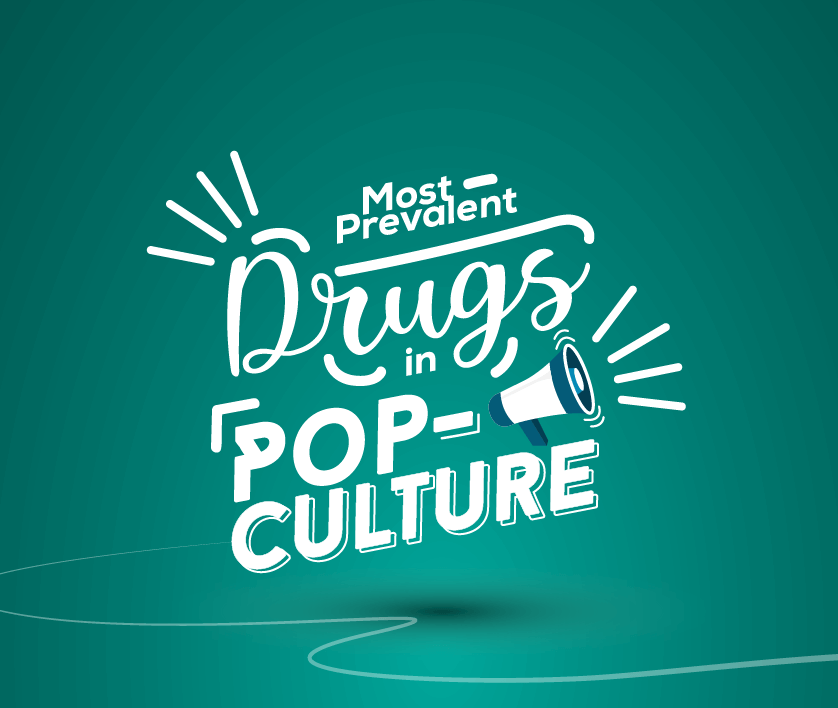
Did you grow up on Homer Simpson and Snoop Dogg? Many of us did. Although Snoop Dogg's lyrics were blatant about his use of drugs and alcohol, many people don't think of Homer Simpson as an alcoholic. America's favorite cartoon father rarely goes through an episode without slamming a few beers, however. Did influences like these affect our decisions as teenagers and young adults? Perhaps even more poignant, is pop culture still influencing your decisions today?
Studies show that pop culture and media have a remarkably negative impact on children and teenagers, as well as young adults. It's estimated that more than half of all high school students try illicit drugs, while more than 70% drink alcohol by the time they graduate. Of those, the youth that struggle with addiction at an early age often begin experimenting with drugs and alcohol by the age of 12 or 13. Keep in mind that the human brain does not reach full maturity until the age of 25, and you can imagine the impact that these behaviors are having on growing young minds.
If you look around, it's not hard to see why young people are so open to the idea of drugs and alcohol. Popular youth-targeted TV shows like Riverdale depict high school students drinking scotch and performing strip teases in bars, while Toys R Us was selling action figures of a meth-toting Walter White only a few years ago. What is the message that's portrayed in these circumstances? "Drugs are cool, man."
Substance use is an accepted - even glorified - part of television programming, movies, music, literature, and even art. It is not lost on our youth, nor are adults immune to these influences. Let's take a look at the role of drugs in popular culture; we're willing to bet you'll recognize more than a few of the references made below.
Sensations: Happy euphoria, slight sedation, loss of inhibitions.
Monikers: Sauce, Hooch, Juice, Booze.
History:Alcohol is one the oldest and definitely the most widespread intoxicant of all time. The drinking of fermented alcoholic beverages goes back almost 9,000 years, and that's only what we have on written record.


Wine was the preferred (or only) beverage for most civilizations until about the 16th century, when hard liquor like gin came into popularity. At this time, there was no public condemnation against alcohol abuse, nor were its health consequences well-known; as a result, alcoholism was rampant. In the 20th century, the temperance movement began, resulting in full alcohol prohibition in 1920. All forms of liquor were illegal in the United States from 1920 to 1933, when it became obvious to everyone that laws against alcohol would do nothing to stop its production or consumption.
Since then, alcohol abuse has become quite common once again; an estimated 15 million Americans suffer from alcohol use disorder.
Cultural significance: Alcohol plays a part in every major civilization; it is by far the most common of all intoxicants. In some societies, alcohol plays a major role in cultural activities. Champagne is necessary to every wedding ceremony while beer must be served at sporting events. Brands and types of alcohol can even define social status and relationships. For example, a sophisticated man may gladly take his double bourbon neat, but he would rarely dain to drink a "girly" apple martini.

Popular appearances: We've already mentioned Homer Simpson's famous love of beer, and the theme of the lovable alcoholic is well-known. The Big Lebowski, Charlie Harper, and Don Draper are all good examples of main characters who have obvious yet seemingly acceptable drinking problems. Then there's the common dilemma of a favorite television character suddenly developing alcohol use disorder, only to spend a stint in rehab and become permanently cured. Grey's Anatomy, This is Us, and 90210 are all guilty of portraying this unrealistic scenario.
Then, there's music. It would seem that every genre has paid tribute to alcohol, and often. Every country music fan can sing "Friends in Low Places" by heart, while punk gave us "40 oz to Freedom" and rap has delivered such favorites as "Gin & Juice" and "Crack a Bottle".
"Cause I've got friends in low places / Where the whiskey drowns / And the beer chases my blues away / And I'll be okay" -- "Friends in Low Places", Garth Brooks
Sensations: Increased sensory perceptions, relaxed euphoria, some psychoactive sensations, sometimes paranoia.
Monikers: Pot,Weed, Green, Chronic, Mary Jane, Ganja.

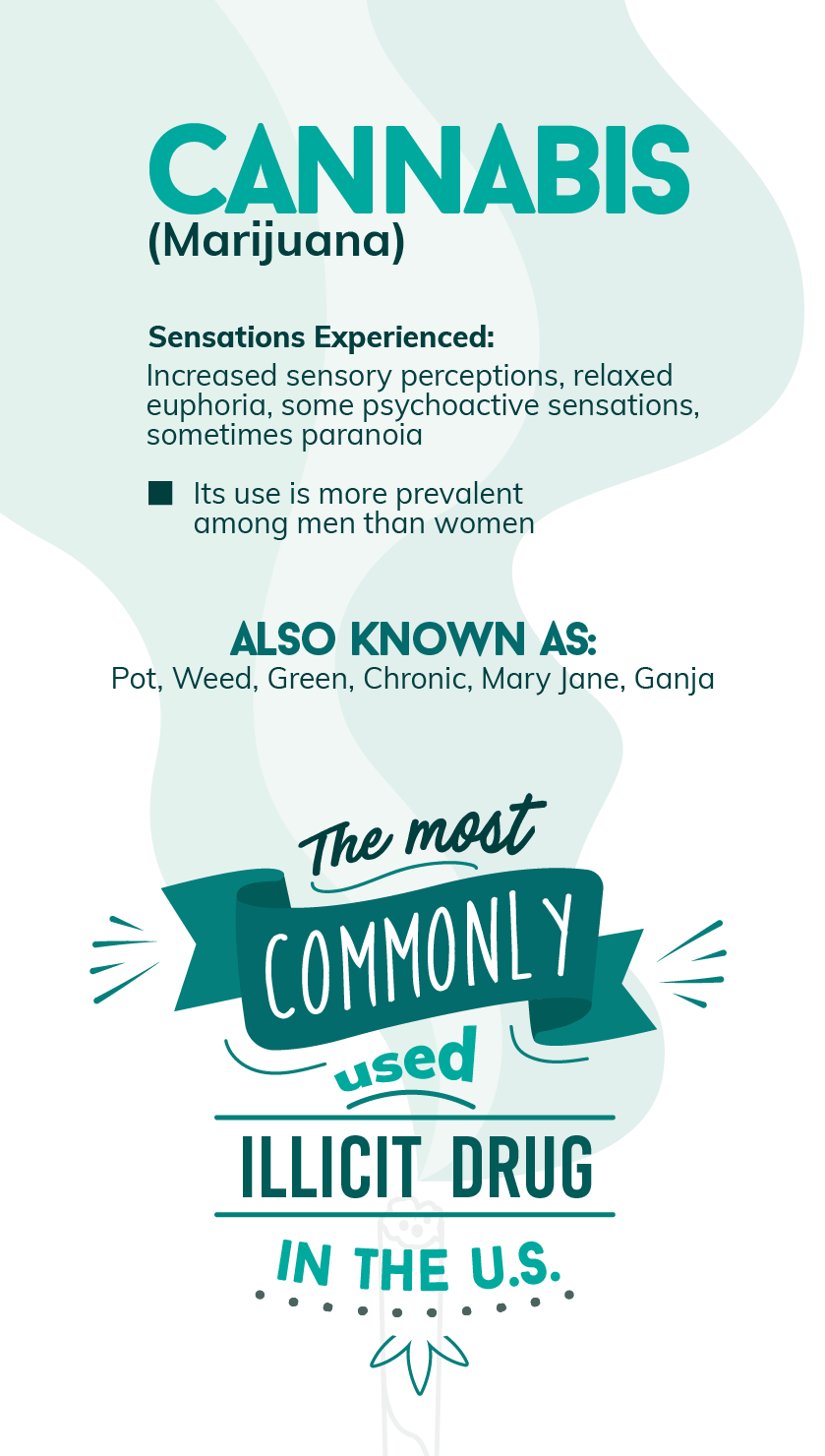
History: The cannabis plant is a remarkably versatile herb. It was originally used as a fibrous material for making ropes and textiles, with only a few ancient Chinese emperors on record that used it recreationally. At some point, marijuana became known as a medicinal herb and was ingested for thousands of years to relieve stomach aches, ear aches, and rheumatism. It only started gaining real popularity in the United States as a recreational drug after the government made it illegal to use recreationally in 1917.
Then, when the church-funded Reefer Madness film depicted marijuana as a notorious narcotic, it officially entered the mainstream as a terrifying illicit drug for fearful parents and a delightful way for teenagers to rebel against those parents.
Today, cannabis is once again popular as a medicinal remedy for nausea and pain as it is slowly becoming legalized across the country.
Cultural significance: After Reefer Madness made marijuana famous as a recreational substance, it caught on in full force during the 1950s. The flower children and beatniks adopted weed as a crowd favorite for hippies everywhere, and it would be forever associated with the counterculture movement of the 1960s. Add to this Bob Marley's famous love of weed and its part in reggae culture, and you can see how marijuana gained a full-on cult following.
Over time, recreational marijuana users developed a subculture with its own rules of etiquette, colloquialisms, art, music, and movies.
Popular appearances: The most well-known pop culture references of cannabis would have to be stoner films. These goofy, unconventional, often ridiculous portrayals of weed-influenced adventures were first popularized in the late 1950s with the debut of Highschool Confidential!. Since then, stoners everywhere have enjoyed movies like Dazed and Confused, Fast Times at Ridgemont High, and of course, Up in Smoke featuring Cheech and Chong.
Marijuana is also a favorite muse in music lyrics, such as Afroman's "Because I Got High" track, or the "bubonic chronic" references in Snoop Dogg's "Gin & Juice". Even books and art feature their fair share of marijuana appearances. (Budding Prospects, anyone?)
SILAS: "So, you're trying to get something to bring your nerves down too, huh, bro?"
JAMAL: "Yeah… I figure if I study high, take the test high, get high scores! Right?"
-- How High
Sensations: Loss of motor coordination (the "lean"), happy, excited euphoria.
Monikers: Purple Drank, Lean, Sizzurp.
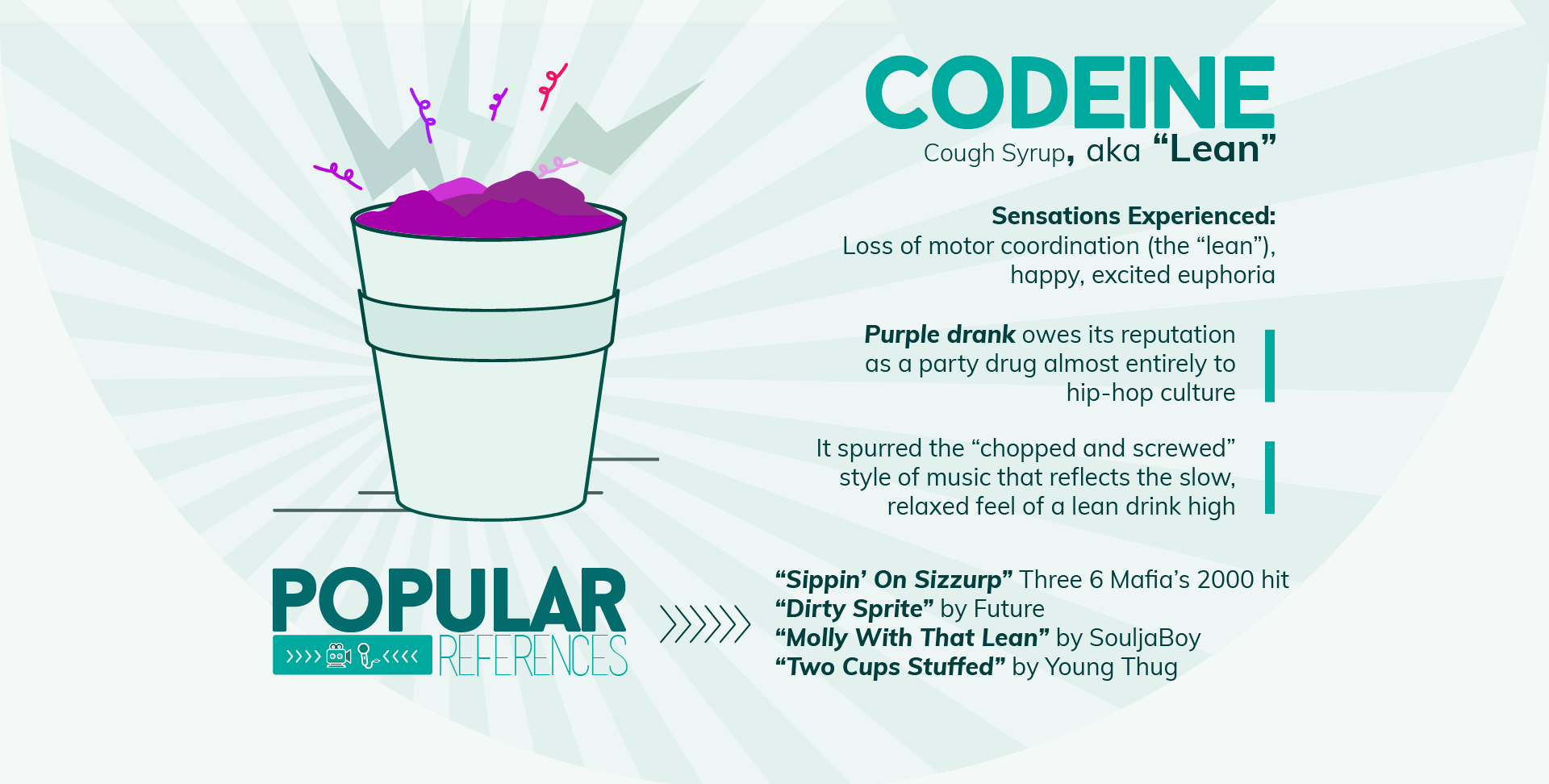

History: Lean drink is a concoction crafted of codeine promethazine cough syrup, Sprite, and Jolly Ranchers. The bright purple brew was popularized in Houston, Texas in the late 1980s among hip-hop and nightclub crowds. For years it was an obscure, localized trend that gained little attention, until DJ Screw brought it into the mainstream.
Houston's DJ Screw was so enamored of sizzurp that he mixed a new "chopped and screwed" style of music that reflected the slow, relaxed feel of a lean drink high. Other artists followed suit with songs like Three 6 Mafia's "Sippin' On Sizzurp", which hit the top of the charts in 2000 and turned sizzurp into a national curiosity.
Cultural significance: Purple drank owes its reputation as a party drug almost entirely to hip-hop culture. However, it is also becoming widely known for its health dangers. Some of its biggest public advocates - DJ Screw, Pimp C, and Big Moe - have died from complications caused by heavy codeine and promethazine abuse. Since all of the above artists hailed from Houston, the drug has become known in the city as a local menace and denounced by many.
Even in mainstream culture, artists like Lil' Wayne have had very public health incidents with lean. That did not stop him from rapping about it, however.
Popular appearances: Besides Three 6 Mafia's 2000 hit, many hip-hop artists have referred to lean in their lyrics. "Dirty Sprite" by Future, "Molly With That Lean" by SouljaBoy, and "Two Cups Stuffed" by Young Thug are all written about the pleasures of lean drink abuse. Lil' Wayne is by far the most prominent of these, however:
"I just drink purple, she just smoke hookah / Quit cigarettes, concerned 'bout her future / I pour up a lot, past, present, future / Syrup and sprite, turn that shit fuschia" -- "Pour Up", Lil' Wayne
Sensations: Sudden confidence, a burst of energy, intense concentration.
Monikers: Coke, Powder, Blow, Snow, Crack.


History: Thousands of years before any white powder ever hit the streets of Miami, indigenous tribes in the Amazon jungle were chewing roasted coca leaves and enjoying their stimulative effects. Consumed in much the same way as chewing tobacco, local tribes of the Amazons and Andes Mountains still use coca in ritual ceremonies today.
It wasn't until 19th-century chemists visited these indigenous communities that cocaine was extracted from the leaves in the form of a fine white powder. Doctors attempted to find a use for it but were unable to use it any way that didn't cause persistent overdose.
Cocaine remained a less-than-useful medicament until pharmacist John Stith Pemberton decided to try adding it to his new recipe for a carbonated beverage. Although coke was removed from the drink after only a few years on the market, it bred an entire generation of people addicted to Coca-Cola, and America was suddenly very interested in cocaine.
Although cocaine was prohibited for any purpose in 1914, it was used recreationally in some crowds even then. Then, in the 1970s, cocaine abuse grew to include over 5 million users. Suddenly, America's War on Drugs was in the limelight, and thousands of cocaine arrests were made in just a few years time.
Cultural significance: Cocaine has had several powerful and simultaneous effects on American culture since the 1970s. On the West Coast, cocaine was pushed hard into Hollywood social circles, allegedly handed out as free samples by cartel contacts at ritzy parties. By the '80s, it had permeated daily life in Southern California and, according to talent manager Jeff Wald, "everyone was doing it."

On the other end of the country, the East Coast saw its first crack houses, and another more squalid side of the cocaine epidemic was being revealed in underprivileged communities. The War on Drugs took its battle full-force into inner-city neighborhoods, landing thousands of underprivileged citizens in jail cells. In fact, it was crack cocaine that fueled the War on Drugs and brought the campaign into the limelight. This had another unforeseen effect - an angry "fuck the police" attitude among inner-city youth that still persists to this day.
Today, the War on Drugs rages on, and inner-city youth are still hauled to jail in the thousands for drug-related crimes.
Popular appearances: Pop culture from the '80s and '90s is rife with cocaine references. There are few movie scenes more iconic than Al Pacino's coke-fueled rage as he meets his enemies with an AR-15 exclaiming, "Say hello to my little friend!" Since then, a range of other cocaine-inspired films have come out, such as Goodfellas, American Made, Blow, and Wolf of Wall Street. Of course, we can't forget the various TV series, movies, and documentaries about the world's favorite evil drug dealer, Pablo Escobar.
Cocaine's pop culture appearances go far beyond movies, however. Stephen King claims that some of his most famous books were hammered out during long powder-dusted nighttime binges. Songs like Eric Clapton's "Cocaine" did not even attempt to be subtle and, even today, Miley Cyrus is still singing about girls "trying to get a line in the bathroom". Despite its dark and harmful past, it would appear that America is not yet through with its cocaine infatuation.
"Oh yeah we are perfect; we are fuckin' beautiful. Ladies and gentlemen, I present to you 100% pure Colombian cocaine." -- George, Blow
Sensations: Euphoria and intense energy, a rush of focus that can become compulsive.
Monikers: Crystal, Ice, Tweek, Crank, Speed.
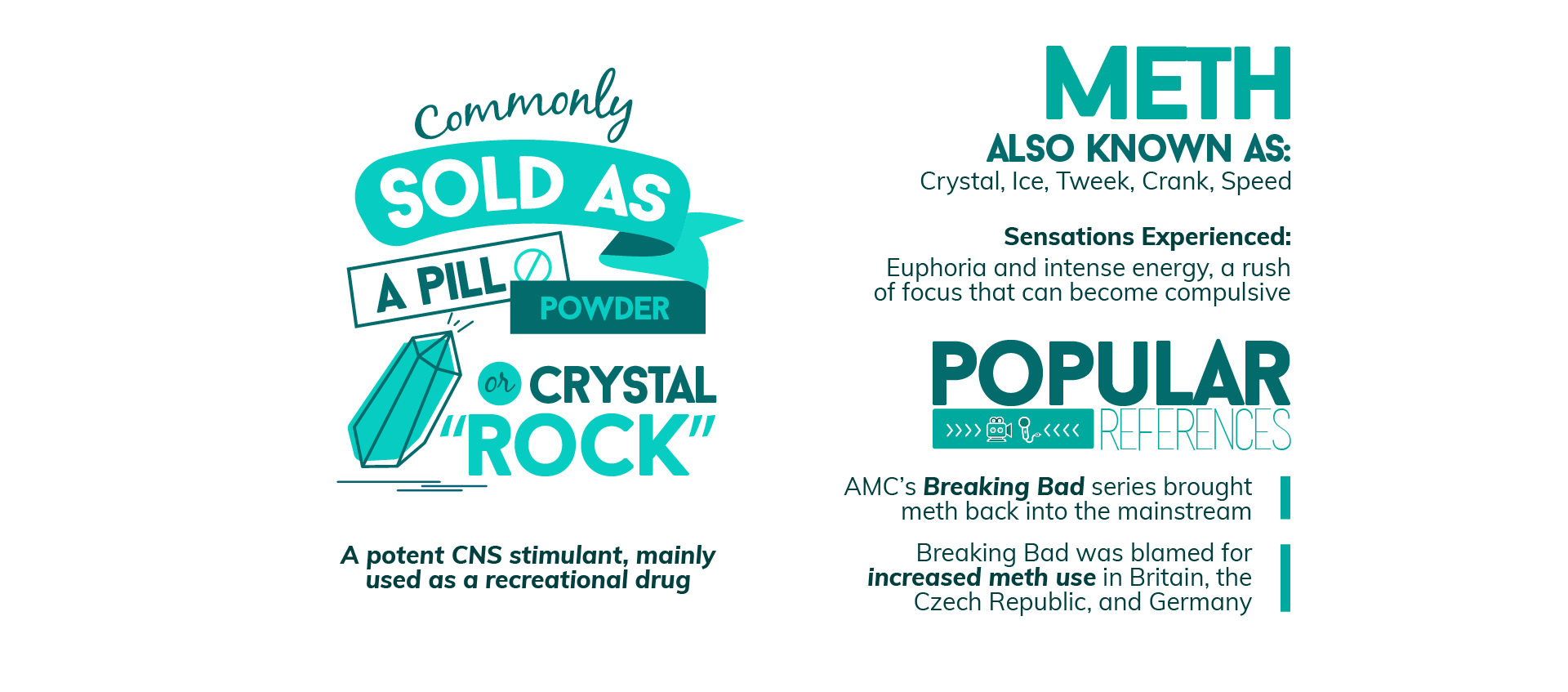

History:Methamphetamines were synthesized from the ephedra plant by a Japanese chemist in 1893 and its stimulative properties were immediately recognized. Doctors tried using it for a number of medical applications, such as treatment for obesity, narcolepsy, and asthma. Then, the military made use of the drug in World War II to energize soldiers to fight exhausting days-long campaigns, and its effects became widely known to the general public.
By the 1950s, meth (which was perfectly legal) was everyone's favorite diet drug and stimulant. Truck drivers and college students happily ingested meth to stay awake for long hours, and its addictive nature was not not widely recognized until the 1970s, when it was finally outlawed. By then, however, the damage was done. Over a million people were using meth at the time of its ban. Since then, the drug has been hedged aside by other illicit stimulants like cocaine, but it remains popular among rural and underprivileged communities.
Cultural significance: Of all the now-illegal types of drugs, meth was the only one to be so widely used by the general population for so long. At one point, meth was prescribed in an almost pure form in inhalers and tablets to treat asthma, obesity, and various psychological conditions.
After its prohibition, meth was no longer manufactured or sold in a pure format, and the vicious effects of smoking the drugs became apparent. Because of its devastating effects, as well as the introduction of other more desirable stimulant drugs, meth gained a reputation as a slummy, dirty substance and was dubbed "poor man's coke". This is when it became a favorite of rural, underprivileged communities without ready access or means to buy cocaine. Recent pop culture influences have brought methamphetamines into a cultural renaissance however.
Popular appearances: Although many pop culture references to methamphetamines exist, one in particular has changed public perceptions of the drug forever. In 2008, AMC's Breaking Bad series brought meth culture out of the trailer park and into 10 million American homes. Although the program by no means praised the cooking and dealing of meth, it did seem to glorify the drug trade, according to police.

The effects of the show's popularity were felt across the world. Even in Europe, officials from the European Monitoring Centre for Drugs and Drug Addiction blamed Breaking Bad for increased meth use in Britain, the Czech Republic, and Germany. Even toy stores were jumping on the bandwagon, selling Walter White figures on shelves beside Barbies and baby dolls. The plastic drug dealing toy even came with his own bag of 'Blue Sky'!
Although it is unclear if Breaking Bad's popularity had any effect on meth use in the United States, the program definitely brought meth into mainstream society once again.
"Let's get something straight. This – the chemistry – is my realm. I am in charge of the cooking. Out there on the street, you deal with that." – Walter White in Breaking Bad.
Sensations: When taken unnecessarily, Adderall brings on a feeling of well-being, energy and concentration, possibly jitters.
Monikers: Addys, Study buddies, Pep pills, Uppers.


History: Amphetamine came out of the same fascination with the ephedra plant that brought us methamphetamines. Although they are much less potent than meth, amphetamine prescriptions known as nootropics, like Adderall, are also stimulants.
Like meth, prescription stimulants were also used to treat a variety of conditions in the early 1900s, such as obesity and asthma. By the 1950s, they were a popular stimulant for mainstream use, especially among college students, who dubbed them 'study buddies'.
In the 1980s, psychiatrists discovered Adderall's usefulness in treating ADHD - an application that soon became the only legal use for the drug. No one forgot its efficacy as a stimulant however; students and professionals across the nation continue to use it more than ever to increase productivity and wakefulness. Many still do not realize the risks of addiction that Adderall holds, or its association with other types of drug abuse.
Cultural significance: Since they were created, prescriptions stimulants have been labelled as an acceptable form of 'smart drug' abuse, mostly due to their seemingly positive effects. Before their use was controlled by law, military officials, Hollywood directors, and other authority figures handed them out to employees in an effort to improve productivity and focus.
The drug has also become associated with the party scene, since many individuals mix Adderall with other substances as a way to stay up all night, perpetuate a buzz, or prolong sexual stamina. Today, Adderall has become almost as popular among nightclub and rave crowds as it is with college students.
Popular appearances: Since Adderall is well-known and even viewed as acceptable by mainstream society, its appearance in books, films, television shows, and music goes almost unnoticed. Unlike other more notorious drugs, it has no shock value, but that does not mean it's not a part of pop culture.
In the popular memoir The Adderall Diaries, Stephen Elliot recounts his own addiction to Adderall and the subsequent mess he made of his life. In television, series targeted at young adults often make references to Adderall and its potential dangers; including shows like 90210, Girls, and Silicon Valley. Its most prominent references in music were made by hip-hop artist Danny Brown, who admits to taking Adderall when working and writing songs. He actually raps about it in the song "Adderall Admiral":

"Eating on an Adderall, wash it down with alcohol / Writing holy mackerel, actual or factual".
Most recently, Netflix released a documentary called Take Your Pills recounting the popularity of Adderall abuse among athletes, professionals, and students.
"Everybody takes Adderall. Everybody." -- Anonymous student in Take Your Pills
Sensations: Powerful euphoria, empathy for people around you, increased sensory perceptions.
Monikers: X, Ecstacy, Molly, E, Disco Biscuits.
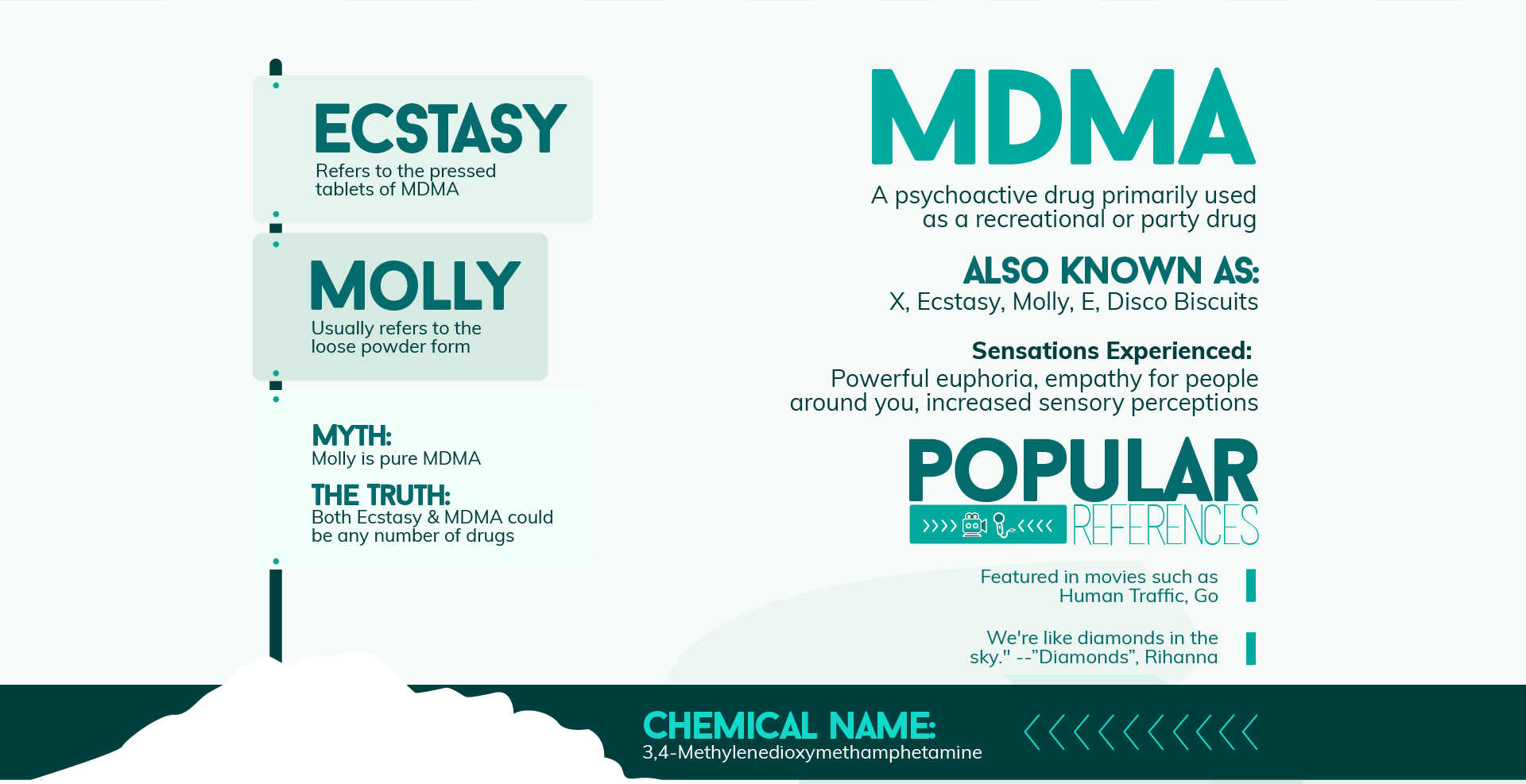

History:MDMA was developed by a German pharmaceutical company in 1913 but was soon abandoned as doctors could find no medical use for the drug. When the US military got their hands on it in the 1950s, they tested MDMA as a potential mind control or psychological drug, again with no reliable results. By this time, psychiatrists across the nation had become aware of its unique psychoactive effects and prescribed it to patients during therapy to help them open up and speak freely.
Even then, the drug remained in relative obscurity until a few people began to experiment with its recreational uses in the 1980s. Ecstasy was an instant hit with young party crowds and it became so popular that the government rushed to add it to controlled substance lists by 1985.
By then, the dance club and party scene was already turned on to ecstasy, and there was no stopping its trajectory to becoming the poster drug of rave and festival culture.
Cultural significance: Some say that MDMA was the impetus that gave birth to rave culture, but others insist that the rave festival came first. Regardless, the two have been symbiotic since the first rave parties took place in London.
It all started when DJ Paul Oakenfold spent one blissful night in an Ibiza island commune dancing to acid house music (a predecessor of electronic) and rolling on ecstasy. He was so taken with the experience that he and three friends decided to recreate the all-night MDMA-influenced trance dance at several nightclubs throughout London. Soon, his events were sold out and other clubs began following his lead. Rave culture was born and soon popularized all over the world. With it came MDMA, and no rave was complete without it.
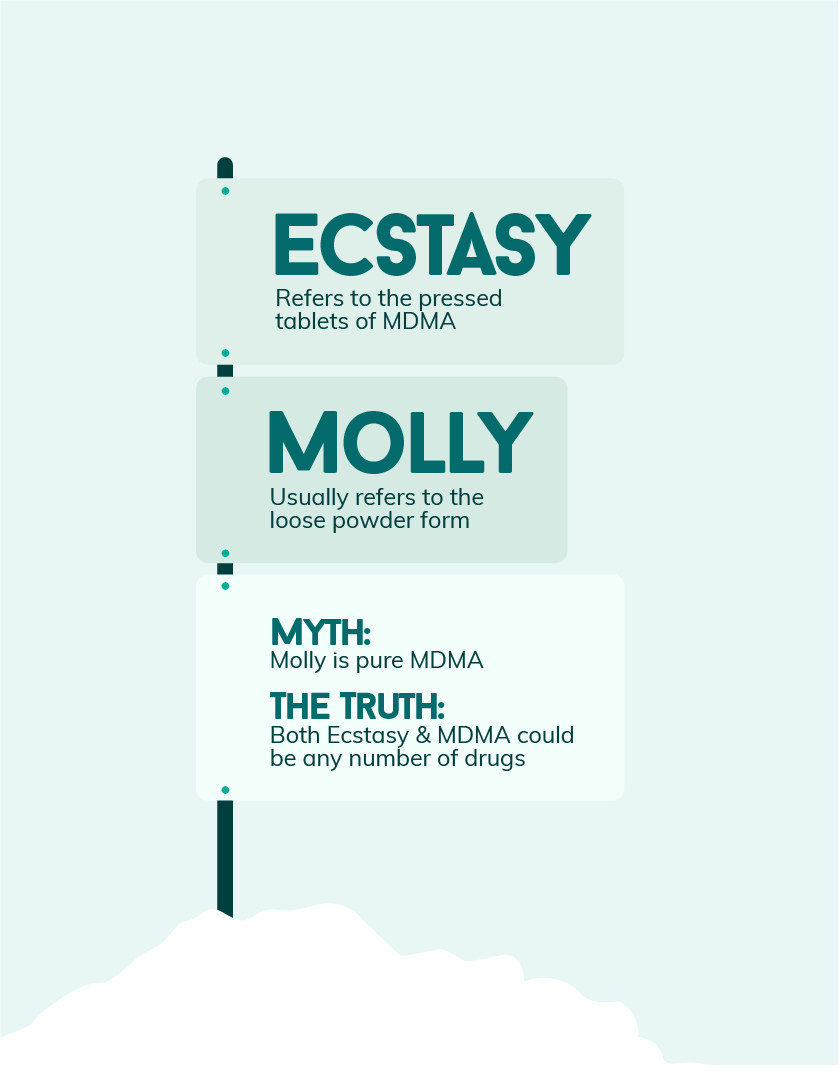
Music festivals and electronic music were also influenced by this movement and continue to grow in popularity today.
Popular appearances: After the rave craze brought MDMA into the limelight, it began to catch on among party crowds in general. Soon, it was the drug of the moment and so, naturally, a lot of low-budget films were made about MDMA during the late '80s and '90s. These included movies such as Human Traffic, Go, and Rave, in which obscure actors spewed incomprehensible lines like, "Present is gone. Fantasy is a part of reality. We take the breaks off. We're thinking clearly yet not thinking at all. This feels right. We stop trying to control things. Warm rush of chemicals through us. We fluctuate. Is this brain damage?" (Human Traffic)
The recent rebirth of MDMA in an allegedly purer format (dubbed 'molly') has brought about a rash of new pop culture references, usually in the form of music. Since the millennials have embraced molly mania head-on, artists like Wiz Khalifa, Miley Cyrus, Madonna, and 2 Chainz have all made references to the craze. The crowd went wild in 2012 when Madonna asked the Ultra Music Festival, "How many people in this crowd have seen molly?"
"Palms rise to the universe / As we moonshine and Molly / Feel the warmth we'll never die / We're like diamonds in the sky." --"Diamonds", Rihanna
Sensations: Intense, heady euphoria, a state of blissful well-being, warmth.
Monikers: Tar, Smack, H, Brown Sugar, Junk, Skag, Dope.


History:Heroin has its roots in opium - a substance extracted from the poppy flower that has its own long history of drug abuse. Opium first appeared on written record in 700 BC as it gained popularity along Chinese and European trade routes. The substance was used to treat insomnia but soon developed into a full-fledged opium epidemic that lasted centuries.
In the 1800s, morphine was derived from opium and became the first widely used injectable painkiller on record. When heroin was synthesized out of morphine, it was hailed as a wonder drug that doctors prescribed for everything from diarrhea to the common cold. Its penchant for addiction was soon recognized and the government prohibited the use of heroin in 1924.
Today, heroin is abused by almost one million people in the United States.
Cultural significance: Heroin has a dangerous reputation, and with good reason. Heroin and other opioids make up the vast majority of overdose deaths. This reputation has influenced overall perceptions of heroin, and most cultural depictions of heroin addiction paint an ugly, almost terrifying picture. Think Trainspotting and Requiem for a Dream.
Despite the caution and fear that surround heroin addiction, it also has an influence in creative circles. Creative cultures have been associated with heroin since at least the 1920s. One of jazz music's most famous contributors - Charlie Parker - openly attributed his genius to the use of heroin. Painter Jean-Michel Basquiat was also forthright about his addiction, admitting to consuming the drug on a daily basis. Both artists died due to the health complications of substance abuse.

Heroin has also had an influence on other types of music. The grunge rock scene of the 1990s was famously intertwined with heroin culture. Bands like Nirvana and Alice in Chains embraced their vices openly, even singing about their use of heroin on occasion. The New York Times labelled Seattle as the hub of "espresso, beer and heroin" in the '90s, a reputation that the city has not completely left behind if Seattle's ongoing opioid crisis is any indication.
Popular appearances: There are plenty of movies that attempt to describe heroin dependence, but many more songs exist that try to capture the heartache of addiction. Sarah Mclaughlin wrote "Angel" to describe a life lost to a heroin overdose, while "Under the Bridge" by the Red Hot Chili Peppers and "Hurt" by NIN both pay tribute to the hardships of the heroin-afflicted lifestyle. What is rare is any pop culture reference that praises or glorifies heroin. It seems that most everyone can agree that heroin is never a good idea.
"I need some distraction / Oh, beautiful release / Memories seep from my veins / And maybe empty / Oh, and weightless, and maybe / I'll find some peace tonight" -- "Angel", Sarah Mclaughlin
Sensations: Relaxed euphoria.
Monikers: C, Percs,Oxycet, Hillbilly Heroin.


History:Percocet is an opioid derived from the same chemicals that give heroin its kick. This mixture of oxycodone and acetaminophen (Tylenol) was developed in the 1970s and initially, doctors were wary of prescribing it. By then, the potential of addiction to opioids was well-known. The pharmaceutical industry answered this reticence with a score of studies and marketing campaigns that promoted effective pain management and the prescription of Percocet to help patients recover from painful injuries or chronic pain.
Doctors became convinced and began prescribing Percocet more regularly. This marked the very beginnings of the opioid epidemic. The medication is still prescribed today for post-surgery and injury-related pain, but it remains even more popular on the black market as a recreational drug.
Cultural significance: Percocet and other prescription opioids like it are almost entirely responsible for bringing opioid addiction into mainstream society. Due to an overabundance of prescriptions in the 1990s, as well as lack of patient education on the dangers of opioids, millions of middle class Americans have found themselves suddenly addicted to painkillers. In some cases, this type of dependence leads to heroin addiction after the prescriptions run dry.
Since 2011, drug overdose has become the leading cause of accidental death. This is clearly due to the current opioid epidemic, since it has never been true before the latest epidemic began. Of course, pop culture is not always wise about its favorite vices, and Percocet remains a popular drug reference in pop culture.
Popular appearances: Hip-Hop artists have no qualms with rapping about drugs, and Percocet is no exception. 21 Savage, Migos, and Future have all made mention of it in their songs, although some of their more recent beats feature a sluggish, mumbling lyrical style that does not speak well of opioid abuse. Despite the doubtful quality of this sub-genre of music, fans seem to enjoy Future's repeated lyrics of "percocet molly percocet" in the song "Mask Off", even bringing this particular combination of drugs into popularity with young listeners.

Eminem has also made frequent mention of drugs like Percocet, although he now claims to regret his abuse of the drug:
"I feel like I'm walkin' a tightrope without a circus net / Poppin' Percocet, I'm a nervous wreck" -- "Rock Bottom", Eminem
Sensations: Powerful euphoria, feelings of well-being and invincibility.
Monikers: OC, OX, Oxy, Blues, Kickers.


History: Like Percocet, Oxycontin was developed from the opioid oxycodone in 1996, but with higher doses and a more powerful effect than its predecessors. The manufacturer of the medication - Purdue Pharma - claimed that its slow-release formula was less addictive than other opioids and convinced doctors that it was the very best option for chronic aches and pains. Obviously, less addictive Oxycontin is not.
It didn't take long for the flood of prescriptions to turn into a flood of addictions, and users discovered that they could bypass the slow-release mechanism of the pill by crushing, injecting, or snorting it. Even as Oxycontin addiction continued to rise, Purdue Pharma ignored the warning signs and continued to market the drug as a 'less-addictive' opioid. By the time doctors and government officials became widely aware of the dilemma, millions of people were addicted to oxy.
Cultural significance: The major cultural implication of Oxycontin is the swift and overwhelming effect it had on the already-budding opioid epidemic. What was slowly growing into a concerning problem in the early '90s suddenly exploded into a full-blown crisis when oxy hit the market as a powerful, high-dose pill.
While the opioid crisis cannot be laid entirely at the feet of Purdue Pharma, their unethical and aggressive marketing tactics certainly had a major part. Responsible doctors were wined and dined, convinced and persuaded in a series of expensive and elaborate marketing campaigns to push Oxycontin as the perfect end-all solution to pain management. The doctors bought it; then the prescriptions and dollar signs came pouring in.
Purdue could have turned back the marketing campaigns when the class-action lawsuits came pouring in from suddenly and unintentionally addicted patients, but they did not. The company continued the same marketing campaigns and false claims even as it became glaringly apparent that oxy was both wildly addictive and wildly popular on the black market. And just like that, an epidemic was born.

Popular appearances: Oxycontin is widely recognized for its addictive properties and penchant for abuse, even in pop culture. Some references use the drug as a comical way of making fun of drug users, such as this exchange from the movie This is 40:
DEBBIE: "You babysat my kids while you were on Oxycontin."
JODI: "Oxycotton."
DEBBIE: "Oxyconton?"
JODI: "Oxykitten."
DEBBIE: "What's oxykitten?"
JODI: "Meow."
Hip-Hop music seems to happily adopt every illicit trend, and Oxycontin is no exception. The usual hard-partying bad boys like Lil' Wayne and Future have made multiple lyrical references to the drug, but one of the more startling references is Macklemore's "Drug Dealer". In the song, Macklemore publicly denounces doctors and government officials for exacerbating the opioid crisis:
"My drug dealer was a doctor, doctor / Had the plug from Big Pharma, Pharma / I think he trying to kill me, kill me / He tried to kill me for a dollar, dollar" -- "Drug Dealer", Macklemore
Sensations: Similar to other opioids, intense euphoria and relaxed sensation.
Monikers: Apache, Fent, China Girl.


History: From the time of its invention in 1968, everyone was well-aware of the dangers presented by Fentanyl. The drug is about 100 times more potent than morphine and has an enormous potential for both abuse and overdose. Knowing this, medical personnel only ever administered it in controlled circumstances through intravenous applications in the hospital or slow-release patches for pain. Then, in 1981, its patent expired.
Without a patent to keep the formula a secret, illegal drug labs soon got their hands on the recipe. Fentanyl was then synthesized and freely sold on the black market. It has been sold in pure format and is also used to cut into other drugs, increasing their potency and their potential for overdose. Recently, Fentanyl became the number one cause of overdose death in the United States.
Cultural significance: The greatest cultural significance of Fentanyl is the sheer danger of its use. As the death toll rises, its reputation as a deadly drug continues to grow. Celebrities like Tom Petty and Prince have died from Fentanyl overdoses only within the last few years, making it even more notorious as a death sentence.
One of the most alarming aspects of illegal Fentanyl use is that it is often cut into other drugs unbeknownst to buyers. Some illicit drug users are dying of overdoses without ever knowing that the Fentanyl was cut into their heroin or cocaine. Although there is no easy solution to this growing problem, it is making both users and dealers more wary of the drugs that are pushed on the street.
Popular appearances: Since it's reputation borders on the morbid, pop culture does not seem eager to make light of Fentanyl or its use. Films like Another Happy Day and Playing God make references to this and other drugs, but it is rarely if ever made light of.


Not even hip-hop artists seem willing to cross this particular line. When Fentanyl is mentioned in a rap song, it is not in a positive sense:
"Is you with me or against me? / I'm a OG now so you need me / Think you poppin' Xanax bars, but it's Fentanyl / (No-no bars, it's Fentanyl) / Think you're living life like rockstars but you're dead now" --Big Bro, Quavo
Sensations: Calm euphoria, pleasurable relaxation.
Monikers: Tranks, V, Yellow V.


History:Valium is a benzodiazepine medication used to treat various symptoms of anxiety and stress. It was invented in 1969 in Switzerland and quickly became the most popular anti-anxiety medication to date. Valium was the first brand name prescription medication to be widely and boldly marketed on a global scale and, as a result, became the most extensively prescribed medication in the United States between 1969 and 1982.
During that time period, any and all patients who presented with symptoms of anxiety, stress, or 'nerves' would be prescribed Valium, making it a favorite among lonesome and exhausted housewives. So common was this scenario that even the well-respected First Lady Betty Ford struggled with an addiction to Valium after it was prescribed to her by the family doctor.
Today the potential for dependence on Valium is well-known, and it is prescribed much more carefully, usually reserved for patients with official anxiety disorder diagnoses. Valium remains a popular recreational drug however and is regularly traded on the black market.
Cultural significance: The wild and almost instantaneous success of Valium as a brand name set a precedent in the pharmaceutical industry. It showed corporate pharmaceutical companies that aggressive marketing strategies could be used to market prescription drugs in much the same way as over-the-counter medications. Following the success of Valium campaigns, other companies followed suit with brands like Xanax and Percocet, serving to effectively deliver psychotropic and potentially addictive medications into the average American household.
Popular appearances: Perhaps the most relevant reference to Valium in the history of pop culture, The Rolling Stones's "Mother's Little Helper" seems to perfectly capture the role of Valium in the 1970s-era household:

"What a drag it is getting old / 'Kids are different today,' I hear ev'ry mother say / Mother needs something today to calm her down / And though she's not really ill / There's a little yellow pill / She goes running for the shelter of a mother's little helper." --"Mother's Little Helper", The Rolling Stones
During Valium's heydey of the 1970s, it was a popular reference in movies and music. Its appearance in the 1979 film Starting Over was a testament to the culture of the day. When Burt Reynolds suffers a panic attack, his brother asks, "Does anybody have a Valium?" Each woman in the place reaches into her purse.
Throughout the '90s and on unto today, music has paid its own tribute to Valium. In the Verve Pipe's "The Freshmen", a girl overdoses on Valium, while Drake and Future have both mentioned the drug in song lyrics. Eminem has also been open about his own love affair with Valium, both before and after his recovery from addiction.
"My mom loved Valium and lots of drugs / That's why I am like I am 'cause I'm like her / Because my mom loved Valium and lots of drugs / That's why I'm on what I'm on 'cause I'm my mom" --"My Mom", Eminem
Sensations: Calm lethargy, tranquil and drowsy.
Monikers: Zanbars, Xannies, Footballs.


History:Xanax is a benzodiazepine tranquilizer like Valium, but more potent. The drug was approved in the late 1970s for anxiety and panic disorders. It is more effective than other medications for the treatment of panic attacks and panic disorders, but it is also more addictive than most other benzos.
Cultural significance: When Xanax was developed, it was marketed as a 'less-addictive' benzo medication. The drug capitalized on the popularity of Valium, and doctors prescribed it for a range of anxiety and panic disorder symptoms.
Once again, false advertising on the part of the manufacturer led to numerous unintentional addictions, and Xanax soon became a popular hit on the black market as a recreational drug. Xanax caught on in big way within hip-hop culture and similar genres. Today it is so entrenched in the music community that Xanax-influenced music purportedly has its own sound called 'pill-pop'.
Popular appearances: Music has taken to Xanax like housewives to Valium, and hip-hop especially embraces the medication as a recreational and delightful drug. Xanax is mentioned in hundreds of songs by the likes of Danny Brown, Eminem, Lil' Wayne, Three 6 Mafia, and Lil' Peep, who died of an overdose of Xanax and Fentanyl.
Despite its popularity in pop culture, Xanax is not to be taken lightly in the world of recreational pill-popping. It is often present in the case of polydrug abuse, such as the polysubstance overdoses that took the lives of Heath Ledger, Amy Winehouse, Whitney Houston, and Brittany Murphy.
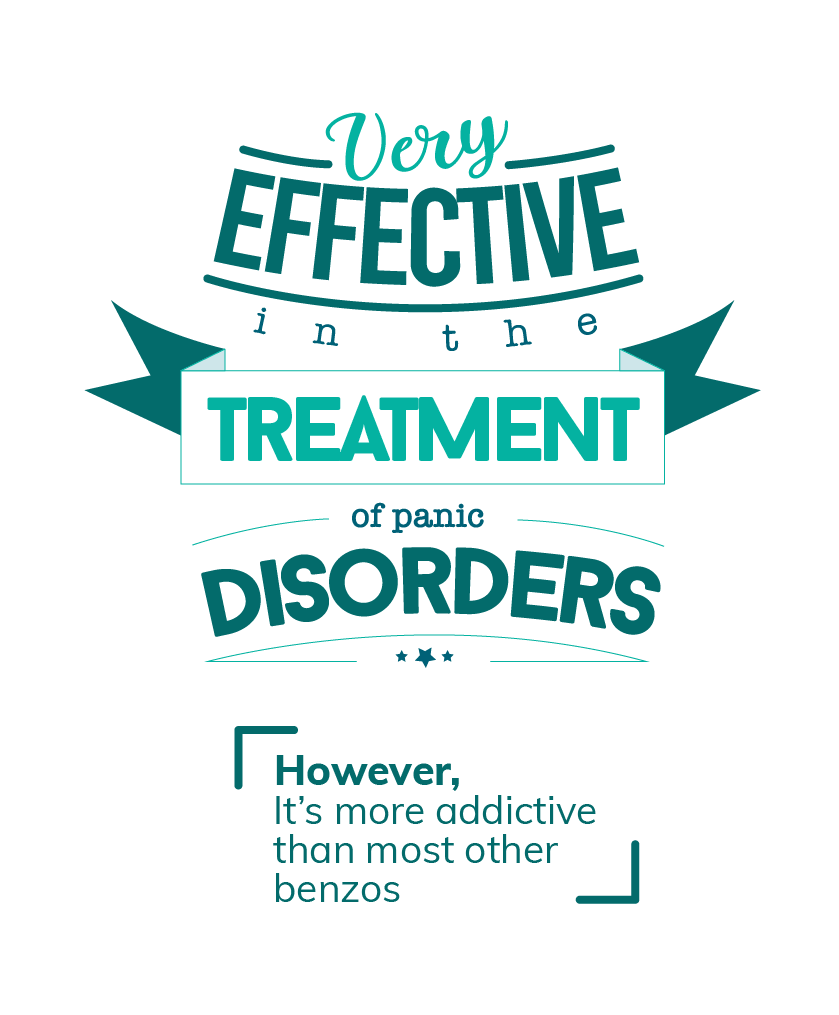
"Grimy n***a way too groovy for the Grammys / Overseas collecting panties, poppin' Xannies…" -- "B*tches N Marijuana", Chris Brown & Tyga
Sensations: Powerful hallucinations, changed intellectual and physical perceptions.
Monikers: Lucy, Acid, Doses.

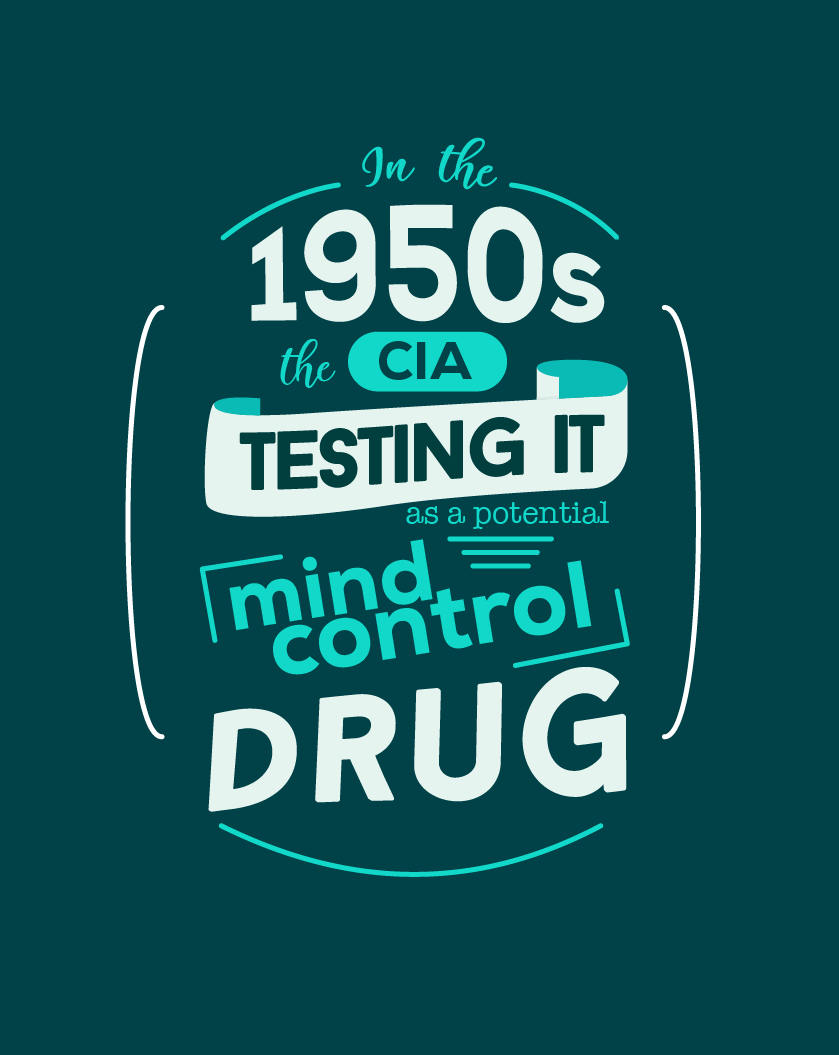
History: Developed in Switzerland in 1938, no one knew exactly what to do with LSD when it was first created. During the 1950s, the CIA was convinced that it could be used as some sort of sci-fi mind control drug. The only results that came out of these studies was that one of the participants - Ken Kesey - became fascinated with LSD and brought it back to his friends in San Francisco in order to share his experience. Kesey and his friends began hosting large-scale parties that they dubbed 'Acid Tests', in which attendees tripped on acid and listened to live music by bands like The Grateful Dead. The Acid Test parties became legendary and incited a movement that became essential to the hippie counterculture revolution.
Meanwhile, professors at Harvard were also interested in the potential of LSD and gave it to a number of students in order to study its effects. As more and more people tried the drug, it became increasingly popular as a recreational pastime.
Cultural significance: Almost every cultural representation from the 1960s hippie revolution is a reflection of LSD consumption. The swirling colors and patterns that graced hippie vans, posters, and artwork of the time demonstrate the visual hallucinations that mark an acid trip. Popular music of the era created by artists like The Beatles, Jimi Hendrix, and the Grateful Dead all features marked psychedelic influences in style and lyrics. Even literature like The Electric Kool-Aid Acid Test by Tom Wolfe speaks openly about LSD usage. It could be said that LSD greatly influenced, even perpetuated, the 1960s counterculture movement as a whole.
Popular appearances: Hundreds of books, songs, and creative works that came out of the 1960s and '70s referenced LSD outright or showed its influences in their penchant towards the psychedelic. Jimi Hendrix sang about "Purple Haze" up in his brain while many suspect that The Doors's "Break On Through" referenced an acid trip.
More modern references are made to LSD as well. Johnny Depp's performance in Fear and Loathing in Las Vegas was a disturbingly authentic portrayal of a long, hard acid trip. The 2010 movie The Men Who Stare at Goats depicts the mind control experiments that the military performed using LSD.

"Purple Haze was in my brain, Lately things don't seem the same / Actin' funny, but I don't know why. 'Scuse me while I kiss the sky." -- "Purple Haze", Jimi Hendrix
Sensations: Giddy relaxed feelings, mild hallucinations, occasional paranoia or fear.
Monikers: Magic Mushrooms, Shrooms.


History:Psilocybin mushrooms have been a part of tribal ceremonies in Africa and the Americas for hundreds or even thousands of years. In 1955 mycologist R. Gordon Wasson became fascinated with spiritual stories about these mushrooms and decided to try them in a village of southern Mexico.
After his experience, Wasson wrote an article for Life Magazine that described the psychedelic properties of the fungus. Since LSD and the counterculture movement were already gaining traction, magic mushrooms became a natural part of the psychedelic-infused culture of the day. Shrooms have remained a crowd favorite as a mild hallucinogen ever since, despite their classification as a controlled substance in the 1970s.
Cultural significance: Even though psilocybin mushrooms were originally only used for spiritual or religious experiences by the ancient tribes that ritualized them, their inclusion in hippie culture promoted the use of mushrooms as a recreational party drug. During the 1960s and on until today, shrooms have been used extensively at music festivals, raves, and other events that promote psychedelic culture.
Other people seek to take magic mushrooms back to their roots as spiritual tools. Several religious and scientific groups have attempted to study and use the drug to gain an improved spiritual awareness. Although this movement does have some avid followers, it is a decidedly small following.
Popular appearances: Because of the giggly, often ridiculous nature of the average mushroom trip, it is commonly used in movies and TV shows to create comical, ridiculous characters. Who could forget the opening scene of the movie Super Troopers, in which a scared college kid eats and entire bag of shrooms and proceeds to freak out completely during his arrest.
"You must have eaten, like, a hundred bucks worth of pot, and, like, 30 bucks worth of shrooms man." -- Super Troopers
Music has also paid tribute to the drug. Incubus's first album, appropriately dubbed Fungus Amongus, seems to have been almost entirely based on the joys of mushroom tripping, and several hip-hop artists have also referred to shrooms within song lyrics. Eminem wrote a song about his regret over feeding a girl psilocybin mushrooms, which caused her an intense and terrifying freakout:
"I never meant to give you mushrooms girl / I never meant to bring you to my world / Now you sitting in the corner crying / And now it's my fault, my fault" -- "My Fault", Eminem
Sensations: Out of body experiences, spiritual revelations, dissociative hallucinations.
Monikers: Businessman's Trip, AMT, Fantasia, DET.
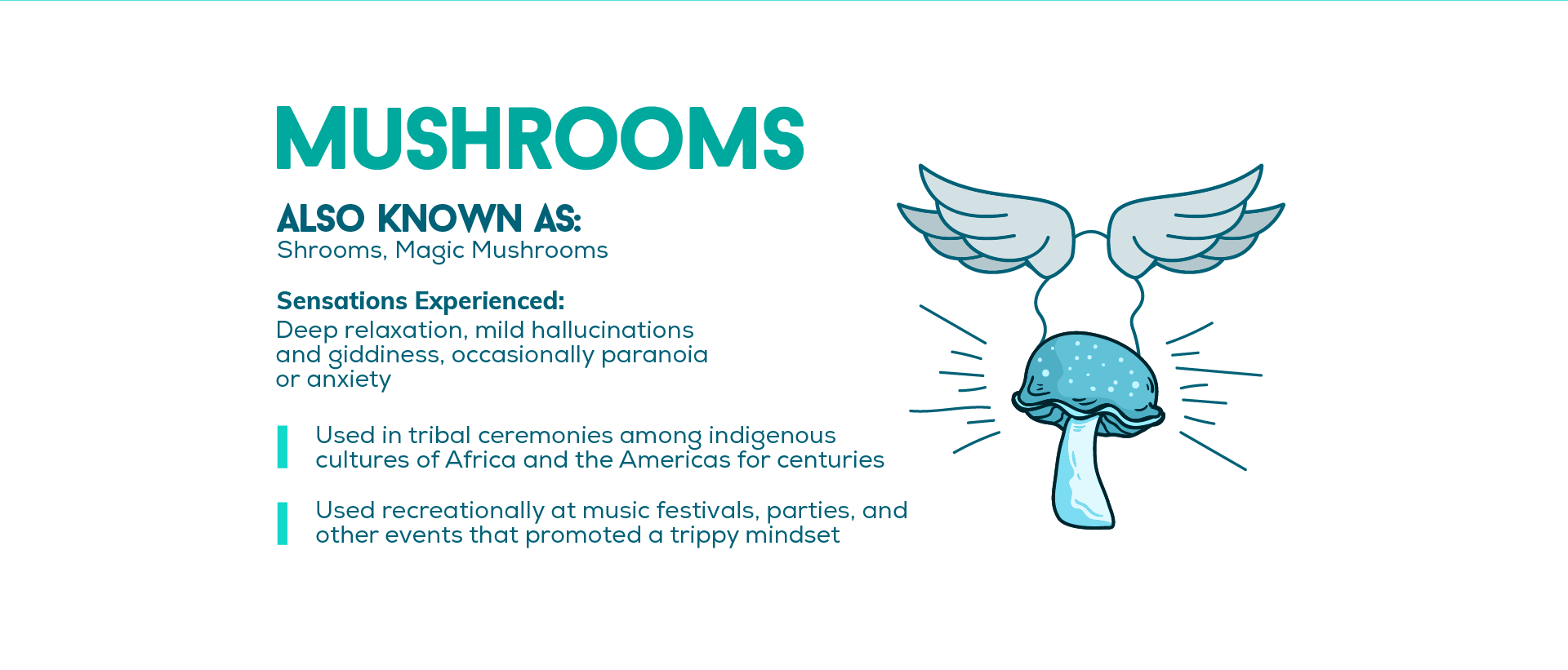

History: Like mushrooms, DMT was originally a sacred, plant-based hallucinogen, although this one was extracted from the bark of a tree in the Amazonian rainforest. Indigenous tribes in the Amazons and Andes Mountains have used it for thousands of years to commune with their gods.
In 1956 it was synthesized into modern-day DMT, but due to the intensity and general strangeness of its effects, the drug never really caught on during the psychedelic craze of the 60s and 70s. In fact, it wasn't until Dr. Rick Strassman published a book called The Spirit Molecule in the 1990s that DMT came out of obscurity. In the book, Strassman explores his spiritual and mind-altering experiences with the drug, creating a great deal of curiosity and controversy among readers.
Cultural significance: Since DMT is relatively obscure and difficult to come by, it has not had a significant impact on culture at large. However, the studies, findings, and written works of Dr. Strassman and his contemporaries have engendered a cult-like following of the drug. These users are convinced that they can achieve spiritual revelations and a raised awareness of the great beyond through their DMT trips.
Popular appearances: Larger circles of pop culture have not adopted DMT as they have other more accessible hallucinogens, but it has come up a few times since The Spirit Molecule was published. The characters in the film Enter the Void are convinced that DMT will open some type of portal or understanding into the afterlife. The movie Renegade also makes mention of the drug while Hulu's series The Path touches on the spiritual possibilities of DMT. In general, however, DMT remains an obscure outlier among pop culture's favorite drugs.
"I thought I had died, and that I might not ever come back. I don't know what happened. All of a sudden, BAM!, there I was. It was the most beautiful thing I've ever seen." ― Rick Strassman, DMT: The Spirit Molecule
As you can see, drugs and alcohol are so prevalent in today's pop culture (as well as culture references of the past) that substance abuse seems almost normal. Depending on your entertainment or genre of choice, your brain may be bombarded with drug references on the hour, every single day. Especially for young, adolescent, and developing minds, this kind of media consumption can condition the psyche towards substance abuse and addictive patterns, altering thinking patterns for a lifetime.
Next time you switch on Eminem or Snoop Dogg, be cognizant of the messages your subconscious mind is receiving and, especially for the young people in your life, remember the subtle effects of pop culture on the growing brain. The media we submerse ourselves in will have an effect on our future decisions.

Our admissions coordinators are here to help you get started with treatment the right way. They'll verify your health insurance, help set up travel arrangements, and make sure your transition into treatment is smooth and hassle-free.
888.450.2153Contact Us